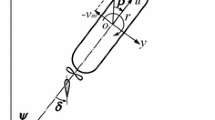Results of calculations of the sonic boom produced by a supersonic passenger aircraft in a cruising regime of flight at the Mach number M = 2.03 are presented. Consideration is given to the influence of the lateral dihedral of the wings and the angle of their setting, and also of different locations of the aircraft engine nacelles on the wing. An analysis of parametric calculations has shown that the intensities of sonic boom generated by a configuration with a dihedral rear wing and by a configuration with set wings remain constant, in practice, and correspond to the intensity level created by the optimum configuration. Comparative assessments of sonic boom for tandem configurations with different locations of the engine nacelles on the wing surface have shown that the intensity of sonic boom generated by the configuration with an engine nacelle on the windward side can be reduced by ~14% compared to the configuration without engine nacelles. In the case of the configuration with engine nacelles on the leeward size of the wing, the profile of the sonic-boom wave degenerates into an N-wave, in which the intensity of the bow shock is significantly reduced.
Similar content being viewed by others
References
V. M. Fomin, V. F. Chirkashenko, and V. F. Volkov, Control of the level of sonic boom created by an aircraft and its drag through the active influence on the process of flow, in: Advances in Continuum Mechanics [in Russian], Dal′nauka, DO RAN, Vladivostok (2009), pp. 719–759.
All-Union State Standard 23552-79, Civil Aircraft. Permissible Levels of Intensity of Sonic Boom on the Ground and Methods of Its Measurement (1980).
R. Wiezien and L. Veitch, Quiet supersonic platform program, AIAA, Paper 2002-0143 (2002).
L. E. Vasil′ev, S. I. Popov, and G. R. Svishchev, Aviation in the XXI century. Predictions and prospects, Tekh. Vozd. Flota, 68, Nos. 1–2, 14–17 (1994).
V. V. Kovalenko and S. L. Chernyshov, On the problem of reduction in sonic boom, Uch. Zap. TsAGI, XXXVII, No. 3, 53−62 (2006).
V. M. Fomin, V. F. Chirkashenko, and V. F. Volkov, Investigation of the sonic-boom problem at the Institute of Theoretical and Applied Mechanics of the Siberian Branch of the Russian Academy of Sciences, in: Problems of Modern Mechanics [in Russian], Omega-L, Moscow (2008), pp. 554−581.
V. M. Fomin, V. F. Chirkashenko, and V. F. Volkov, Method to Reduce the Sonic-Boom Level, RF Patent No. 2341832; published 20.12.2008, Byull. No. 35.
V. M. Fomin, V. F. Chirkashenko, V. F. Volkov, and A. M. Kharitonov, Influence of the configuration of supersonic aircraft on sonic-boom parameters, Teplofiz. Aéromekh., 18, No. 4, 525−541 (2011).
V. F. Volkov, Influence of the configuration elements of a model of a supersonic passenger aircraft on the parameters of sonic boom, J. Eng. Phys. Thermophys., 90, No. 2, 449–460 (2017).
V. V. Vyshinskii, E. N. Kuznetsov, and P. D. Mikhailov, Bodies of revolution with minimum drag in a transonic flow, Uch. Zap. TsAGI, XХIII, No. 2, 78−81 (1992).
M. D. Brodetskii, A. A. Raéfaélyantz, and G. A. Cheremukhin, Experimental study of the influence of engine nacelles on the aerodynamic characteristics of the wing at supersonic speeds, in: Aerodynamic Interference in Flow Past Spatial Bodies [in Russian], Izd. Inst. Teoret. i Prikladnoi Mekhaniki SO RAN SSSR, Novosibirsk (1980), pp. 30−54.
V. F. Volkov, Numerical investigation of spatial flows in the vicinity of complex configurations, Vychisl. Metody Programmir., 5, 62–73 (2004).
V. F. Volkov, Mathematical simulation of a supersonic flow around complex objects. Influence of the position of a wing on the gasdynamic characteristics of a complex object, J. Eng. Phys. Thermophys., 79, No. 3, 467–475 (2006).
Yoshikazu Makino, Takashi Aoyama, and Toshiyuki Iwamiya, Numerical optimization of fuselage geometry to modify sonic-boom signature, J. Aircraft, 36, No. 4, 668−674 (1999).
G. B. Whitham, The flow pattern of a supersonic projectile, Commun. Pure Appl. Math., 5, No. 3, 301−338 (1952).
O. S. Ryzhov, Attenuation of shock waves in stationary flows, Prikl. Mekh. Tekh. Fiz., No. 6, 36–43 (1961).
O. S. Ryzhov, Attenuation of shock waves in inhomogeneous media, Prikl. Mekh. Tekh. Fiz., No. 2, 15–25 (1961).
V. F. Chirkashenko and Yu. N. Yudintsev, Development of the Procedure of Measuring Acoustic-Shock Parameters in Supersonic Wind Tunnels, Preprint No. 6 of the Institute of Theoretical and Applied Mechanics of the Siberian Branch of the Russian Academy of Sciences, Novosibirsk (1983).
V. I. Biryuk, M. R. Ibragimov, V. V. Kovalenko, A. P. Novikov, V. N. Titov, T. Ya. Chaika, Yu. N. Chernavskikh, and V. G. Yudin, Prospects for reducing the level of sonic boom of new-generation commercial supersonic aircraft, Uch. Zap. TsAGI, XLI, No. 5, 13−18 (2010).
Author information
Authors and Affiliations
Corresponding author
Additional information
Translated from Inzhenerno-Fizicheskii Zhurnal, Vol. 91, No. 1, pp. 172–183, January–February, 2018.
Rights and permissions
About this article
Cite this article
Volkov, V.F., Mazhul’, I.I. Numerical Investigation of the Influence of the Configuration Parameters of a Supersonic Passenger Aircraft on the Intensity of Sonic Boom. J Eng Phys Thermophy 91, 161–171 (2018). https://doi.org/10.1007/s10891-018-1731-1
Received:
Published:
Issue Date:
DOI: https://doi.org/10.1007/s10891-018-1731-1




